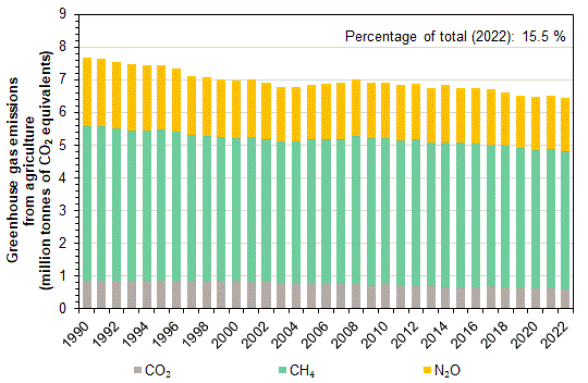The Agriculture sector shows the greenhouse gas emissions from livestock, fertiliser use and energy consumption. These mainly consist of methane (CH4) and nitrous oxide (N2O). Carbon dioxide (CO2) emissions result from the use of fossil fuels and from lime and urea fertilisers. They make a smaller contribution to greenhouse gas emissions in the Agricultural sector.
In terms of total CH4 and N2O emissions, the Agriculture sector is way ahead of all the other sectors. The CH4 emissions in the Agricultural sector are mainly due to cattle rearing and the use of farmyard manure. The N2O emissions primarily come from agricultural land and, to a lesser extent, from farmyard manure use. On agricultural land, N2O is released through the biodegradation processes of nitrogen inputs (commercial fertiliser and farmyard manure, harvest residues, etc.). The relatively lower CO2 emissions come from the use of fossil fuels (greenhouses, grass drying, agricultural and forestry machinery and vehicles) and from lime and urea fertilisers.

Not only is agriculture responsible for the greenhouse gas emissions shown here, but also influences the greenhouse gas balance of agricultural soil in the Land Use sector. The associated emissions and removals are shown on the following website:
Further information
Documents
Kenngrössen zur Entwicklung der Treibhausgasemissionen in der Schweiz (1990-2022) (PDF, 1 MB, 15.04.2024)Stand April 2024 (in German, also available in French)
Klimawirkung von Treibhausgasen und weiteren Substanzen (PDF, 239 kB, 15.04.2024)Faktenblatt (in German, available also in French and Italian)
Data
Emissionsübersicht: Tabellen zum Bericht (Version April 2024) (XLSX, 350 kB, 15.04.2024)Tabellen zum Bericht «Emissionen von Treibhausgasen nach CO2-Gesetz und Übereinkommen von Paris» (in German, also available in French)
Last modification 15.04.2024





